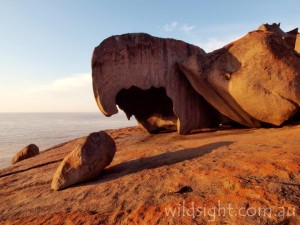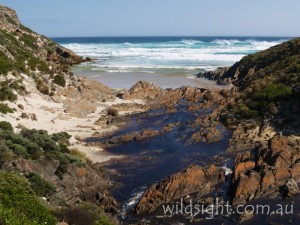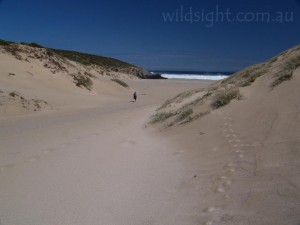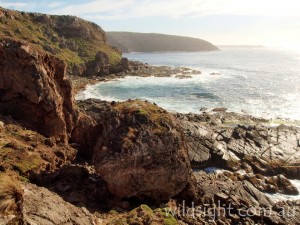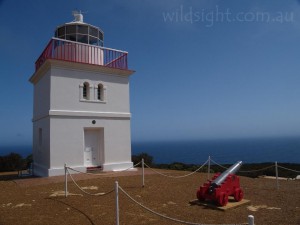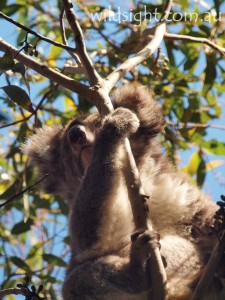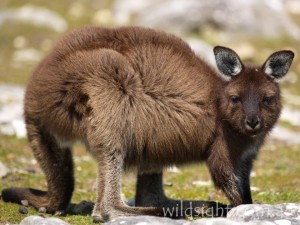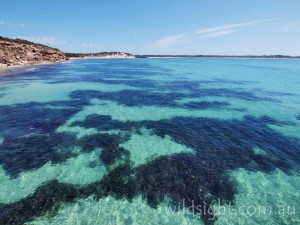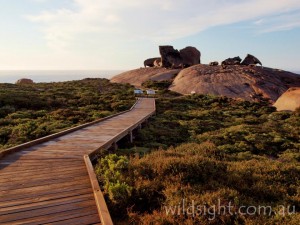It won’t come as a huge surprise to learn there are a lot of kangaroos at Kangaroo Island, and that’s how the island got its name. But Australia’s third-larget island is also home to healthy populations of a wide variety of native animals including koalas, wallabies, emus, goannas, unique “blonde” echidnas and lots of playful seals. They are all easily seen by human visitors, often close-up on easy walking tracks around the island’s rugged coast. The animals take advantage of the isolation that has kept foxes and rabbits away and a spirit of independence that has endured since escaped convicts and runaway sailors helped form Australia’s first free European settlement. About half the island has never been cleared and a quarter of it is preserved in national parks and other reserves, which means there is no shortage of places to explore.
NOTE: Kangaroo Island suffered extensive damage in the 2020 bushfires. Check with local rangers and tourism operators for latest conditions.
Remarkable Rocks (1km, 15 minutes)
Start/finish: Remarkable Rocks car park
Turn off the road to Cape du Couedic just before the lighthouse and follow the high cliffs to a large car park, where a wooden boardwalk leads to Kangaroo Island’s most iconic location. Giant boulders sit perched on a granite headland, carved by the elements into bizarre shapes. Allow some time for wandering between them before returning to the car park.
Platypus Waterholes walk (4.5km, 2 hours)
Start/finish: Flinders Chase National Park visitor centre
An easy return walk past Black Swamp to waterholes that are home to elusive platypus. Allow some time to look for the elusive monotreme.
Rocky River (9km, 3 hours)
Start/finish: Flinders Chase National Park visitor centre
A good half-day loop through diverse forests. Start by heading west via the Black Swamp lookout shelter to the Rocky River Bridge then turn north to follow the river, crossing it several times on the way to Platypus Waterholes. Complete the short circuit around the waterholes – keeping an eye out for a shy platypus – then head south to return to the visitor centre via Black Swamp.
Hanson Bay hike (18km, 6 hours)
Start/Finish: Kelly Hill Visitor Centre
The trail meanders through pink gum woodlands to Grassdale Lagoon then passes south-west river en route to the ocean via coastal heath and sand dunes. The bay itself is a stunning turqoise. Drink in the view before returning via the same route.
Sandy Creek (3km, 1.5 hours)
Start/Finish: Sandy Creek car park, West Bay Road
A different walk that follows a dry creekbed and large sand dunes to reach a remote and beautiful beach, known (perhaps unsurprisingly) as Sandy Beach. Allow time to explore and expect to get sand in your boots! A creek crossing is required in wetter months.
Curley Creek (11km, 4 hours)
Start/Finish: Curley Creek car park
A rare non-coastal walk in the middle of the island with the attraction an excellent view over Murray Lagoon from Bald Hill. Starting at the car park on Seagers Road, head east on an old fire access track; the Bald Hill lookout is the turnaround point. Expect to see lots of birds and a wide variety of vegetation.
Cape du Couedic (2km, 40 minutes)
Start/Finish: Cape du Couedic lighthouse
Park at the lighthouse and take the long route to Admirals Arch (a shorter version is available from another car park closer to the arch). This is a far better walk, featuring extensive views from a series of coastal lookouts and interpretive signs that provide an insight into the Aboriginal and European history of this remote spot. The arch itself is reached via a spectacular set of wooden steps and provides close-up views of a colony of New Zealand fur seals.
Ravine das Casoars (8km, 4 hours)
Start/Finish: Ravine des Casoars Road
A challenging hike regarded by many as the best walk on the island, capped by fantastic views of wild beaches and sea cliffs. Start at the car park at the end of the road, 7km south of the Playford Highway near Cape Borda lightstation. The track follows a narrow valley – or ravine – west to the Southern Ocean. The track is rough in sections and involves some climbs, descents and river crossings (which you may have to wade). On the return trip take a detour north where a track joins 1km from the coast to complete a circuit back to the car park.
OTHER THINGS TO SEE AND DO
Day touring can take you to plenty of great sights that can be seen without wandering far from the car including several lighthouses and stunning beaches. Adventurers can try quad biking or riding a taboggan down the sand dunes at Little Sahara but most visitors prefer a slower pace that involves lazing on beaches, fishing or visiting an art gallery. Kangaroo Island is also a foodies’ paradise with restaurants showcasing local produce or you can go straight to the source at attractions including a honey farm, sheep dairy and a series of wineries.
FLORA AND FAUNA
The island features just about the full range of popular Australian wildlife, often with its own unique take. The echidnas here have “blonde” spines and the kangaroos are darker and stockier than their mainland cousins. This is also a fantastic place to watch marine life up close, with dolphins seen off the coast near Penneshaw and a colony of Australian sea lions on the beach at Seal Bay – take a tour with a ranger to walk on the sand and see them at close quarters. Other species of seals are found splashing in the rockpools near Admirals Arch.
HOW TO GET THERE
Regional airline Rex runs flights from Adelaide but most visitors access the island by ferry which takes 45 minutes from Cape Jervis, a 2-hour drive from Adelaide via the very scenic Floreiu Peninsula (allow more time to see the delightful beaches along the way). The ferry isn’t cheap – see sealink.com.au for more information. On the island sealed roads link the key towns and Flinders Chase National Park at the western end, but many of the best sights require travel on gravel. Keep in mind the island is 150km wide and it takes about 2 hours to drive from the ferry terminal at Penneshaw to Cape du Couedic.
WEATHER
Kangaroo Island has a temperate climate and is an excellent outdoor destination all-year round. Autumn and spring are the best times for walking with long, balmy days and calm seas. Summer can be very hot and in winter cold fronts roar in off the Southern Ocean.
CAMPING AND ACCOMMODATION
If luxury is your go check into the six-star Southern Ocean Lodge – but expect to pay for it. For the rest of us there is a range of more family-friendly accommodation and there are four campgrounds in Flinders Chase National Park. Rocky River is the largest with 22 sites plus toilets, hot showers and gas barbecues. Or you can stay in one of the three lighthouse keepers’ cottages at Cape du Couedic.
SAFETY/WARNINGS
Fire danger season November 1 to April 30 and no wood fires are allowed in Flinders Chase National Park in this time. Be prepared to call off a hike on days of extreme heat and if camping out beware it can be uncomfortably cold at night. Some tracks are close to the edge of cliffs – always take care.
The introduced fungus phytophthora cinnamomi is common on Kangaroo Island and kills native plants and wildlife. Help prevent its spread by cleaning walking boots and tent pegs.
TRACKS
Most are well maintained but there are some rough sections and some tracks require walking on sand.
MORE INFORMATION
Visit the South Australian National Parks service website at or phone the rangers on (08) 8553 4450 for more on what to do in Flinders Chase National Park.
South Australian tourism has info on all the island’s attractions.
